The Hellenistic Navies and ships (334-31 BC)
This chapter is about “greek” vessels, but not confined in the Aegean islands or Greek peninsula. When Alexander of Macedon, after his father was assassinated was proclamed king, one of his first moves was to quell a rebellion in Thebes, after which he secured the loyalty of Greece and could take on the conquest of Persia. This long drawn affair led to the creation of an immense empire, rule from Babylon. Alexander died young, leaving no clear successor, and his empire soon fragmented between his former companions, generals now self-proclaimed kings, called the “diadochi”. A war soon followed for the inheritance of Alexander, but ended as a partition between Antignonos and Cassander in Macedon, Antiochos in the Seleucid Empire, Lysimachus in Thrace and Pontus, or Attalus in Pergamum. Despite the war ended, rivalry often degenerated into open conflict in many occasions, whereas an obscure city in the Latium was just getting started.
After its first test in Italy with Pyrrhos, the west soon saw the rivalry of Rome and Carthage, while in the east, Antiochos “the great” reclaimed the Seleucid Empire and even contested India, while the east saw both the preeminence of the Mauyan Empire and Xin dynasty with Xin Shi Huangdi as first Emperor of China. Rivalry with the Prolemaic Empire led to countless wars over Syria, until Rome, concerning the Illyrians, took a foothold in the Balkans and starting meddling with Hellenic affairs. The fall of Greece itself happened after the fall of Macedon in 197 and the Battle of Corinth in 146 BC. Soon, the Mediterranean became a “Roman lake” with a divided east. The last years of the Republic saw the war on pirates by Pompey, the socii war, the Mithridatic and Armenian wars, and the Roman civil war.
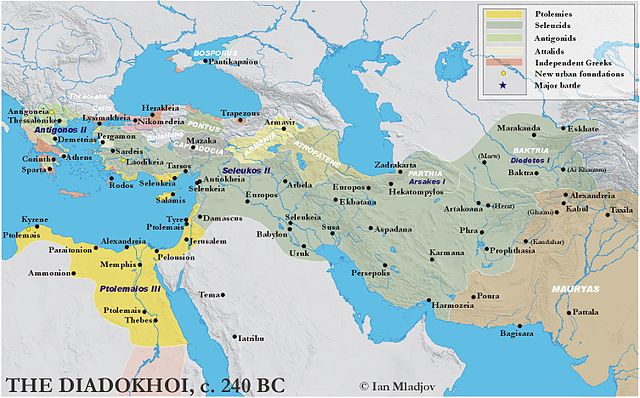
The ancient world in 240 BC (cc)
Devoured by the Parthians and rotten by internal strifes, the Seleucid Empire was left to a powerless, small buffer zone, until the divide of the Roman Republic after the assassination of Caesar and civil war with Brutus, the sons of Pompey and the senate faction, followed by the final showdown between Caesar octavius (future Augustus) master of Rome, and Caesar’s former lieutnant, Antony, master of the east and merging his fate to Cleopatra’s Ptolemaic egypt. The naval defeat at Actium in 31 BC consecrated the last independent Hellenistic Empire, and therefore the end of the “Hellenistic era”, and the start of a ten centuries long Roman era, which for some ended with the fall of the western Roman Empire in 376-476 and others, the fall of the Byzantine (Eastern Roman) Empire in 1453.
During all this time, naval technology advanced, but not as much as it could be expected: When Alexander the great started naval operations against independent coastal city-states, the ships he used were the same as centuries before. The Peloponnesian war saw most of its advancement, and the triumph of the triere: Three rowers at different levels and a light ship made for speed and ramming tactic.
During the Diadochi era however, local Rulers tended to affirm their prestige and supremacy by building massive ships. The “4” or Tetrere already was born during the Punic wars and the Pentere or “5”, better balanced, started to replace the triere in all Hellenistic fleets of the time. As rare records showed, fleets counted a large number of triere still, but also light ships inspired by the aegean pirates, like the Lemboi, Penteres, and some number of larger vessels, ‘6’ and ‘7’, up to the admiral ’10’ or Dekere. Prestige vessels like the mighty Tesserakonteroi or ’40’ was nothing more than a Prince dreamship, more palace than practical military asset.
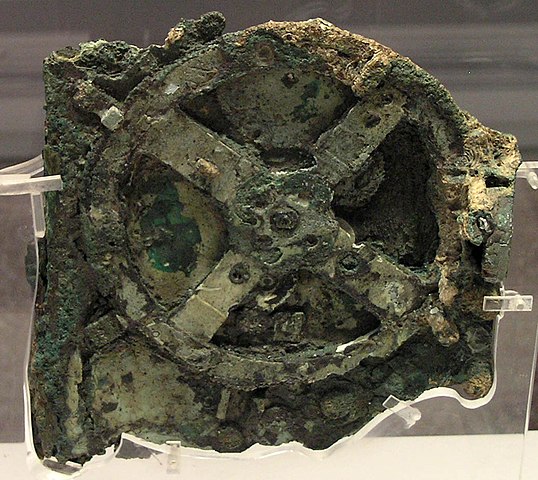
Due to their sheer weight, these heavy ships, from the Pentere on were all “aphraktoi”, meaning the rowers were covered by a full deck, which enabled troops to take place as well as siege engines, ballistae and katapeltes. The Romans already won ove the Carthaginians by relying on these rather than trying themselves to ramming tactics, ensuring borading with the corvus and the superiority of their infantry. The Greeks also developed a naval infantry, the “Epibatai”, following this trend around 200-150 BC. But tactics were really diverse and all types of ships were used to their respective advantages.
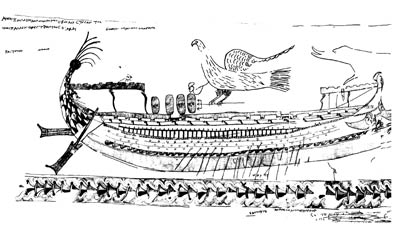
Isis “trireme” from the Nymphaion fresco, assumed to be 60 m long, 15 m height vessel. This was Ptolemy II’s Philadephus prestige vessel, more likely a dekere, still with three rows ranks (5+3+2).
Actium was won not by giant ships (like the Hellenistic Ptolemaic Navy used) but scores of Liburnae, light ships developed from the Illyrian pirates of the same name. Octavian’s gifted admiral, Agrippa, simply out-manoeuvered and overwhelmed them. After this, the Mediterranean became a “roman lake” with just local based fleets patrolling to prevent piracy and protect trade. There was little progress until the split, and the Eastern Roman Empire revived a first class navy, still galley-based, in which Admirals and sailors were speaking greek again. But that’s another story.
Nomenclature
In many respects, naval warfare in the Mediterranean is comparable to what the nations of the world experienced at the time of the First World War: an “arms race”, and the primacy over those who would build more capital-ships than His opponents. If the difference could be made at the speed, armor and caliber, density of artillery, at the time of Pyrrhus of Epirus and Philip of Macedon, it was made to size alone: For simple tactical reasons , Since the ramming tactic was queen and in this shock fight the heaviest galleys were the most devastating. In addition, a large galley was completely decked, giving off room for combatants and siege weapons.
The terms are indeed interesting, since whatever their category, these ships above the triere are counted as “kataphraktoi”, which means “decked” as “heavy” or “protected”. It is true that brass plates were probably applied to the flotation in order to avoid seeing the structure always light, to see itself torn by a bronze rostrum. This flight, which is due to the increase in the number of rowers, concerns at the outset only the concern to make the triremis more efficient by placing two rowers at the lower level (longer rowing) or at the rank of the Thalamites. On the other hand, there are only a few bas-reliefs that tell us of the galleys of that period, Rome apart. And we discover “diere” (2 rows). Must we conclude that, in practice, the control of three ranks was difficult and required a long training which the emergencies of the war made impossible?
The Penter
Therefore the standard returned to two rows of oars, in particular because the compromise between the slopes of the benches, bypass and breadth of the boat became insoluble with three rows beyond a certain number of rowers per bench. The first, the Tetra, is “4”, would in all probability first have been created by the Syracusans to succeed the trireme by having two Thalamites instead of one. The Rhodians probably introduced the two-row tether, which was probably simpler to handle and less tall, and therefore less heavy. And as the idea was obviously good, one approached the penter, or “5”, standard ship of the great Mediterranean fleets at least until the total domination of Rome on its “Latin lake”. The Roman Quinqueremis imposed their laws on the Greek Penter for reasons of combat technique rather than tactics. It seems that three-row penteres of oars have inspired the Roman quinqueremis whose three-row representations are the most common.
In any case, the penter formed the bulk of the fleets of the Hellenistic period, and the triere became supporting ships, the penteconter or the rare divisions of ships of liaison or harassment. This composition is due to the ancient military tactics, described accurately by the classical authors, since the Peloponnesian War (5th century), to the confrontations between the great empires born of that of Alexander the Great. The Lagids, the Seleucids (to a lesser extent), the Greek cities (from Sicily to Asia Minor) and Macedonia, Carthage, not to mention Rome, were protagonists of these giant battles. The three tactics in force at the time had in common the fact that they were conducted near the coast, so much so that the image of Epinal of the admiral or of the general giving his orders from a promontory of the coast, Is not so improbable, and especially that the ships were lightened to the maximum (no food, masts and sails deposited in port). The ramming manoeuvrer was only carried out by the force of the arms.
The first of these tactics was the Periplous, which was designed to wrap the opposing fleet in order to attack it on the flanks and backwards, an exhausting tactic for the rowers, the Diekplous, consisting of passing through the enemy fleet in Constituting two columns of galleys, carried out in front, and intended to break the oars of the adversaries. The latter, immobilized, was attacked from behind and in the middle by the assailants, at the boarding. This tactic prevailed for centuries so much so that Admiral German Hipper at the head of his battle cruisers similarly charged the opposing fleet at the Battle of Jutland in May 1916. Finally, the tactics of the “Kuklos “, The” defensive circle “was a concentration of ships in a circle, rosters turned towards the outside, and aiming, like the compact mass of the phalanges on earth, to make vain any attempt of breakthrough by the assailant. This purely defensive tactic worked with various fortunes in case of obvious numerical inferiority.
The Hepter

Although the wise eye can compare this ship to a dier (2 rows of oars), it was rather a “7” of the Macedonian fleet. A true cruiser of the time, this type was common as squadron leaders. They were supposed to be faster thanks to their 175 rowers on board (350 in all), counted on an onboard infantry unit composed of Peltasts and hoplites, and on four short and medium range ballista. Their rigging (not shown here) often included two rigged square masts, to add a little lift in medium wind and relieve the rowers. The latter were divided at the rate of three on the lower rowing and four on the upper (longer).
The hepter possessed two complete bridges, the first above the rowers and allowing the evolutions of troops and weapons of throw, and one under these same rowers, intended for provisions, water-bottles, reserves of pitch or vinegar, And possibly spare and lumber. Two details are to be explained: Just under the crest of prow there is a small ram’s head. Far from being trivial, the latter was in fact the meatus of a tube throwing pitch under pressure, possibly lit by archers or peltastes, prefiguration of the Byzantine flame-throwing siphons. Moreover, a strong rope is visible at the rear, on the stern, intended to stiffen the latter made of planks light enough to be curved in this way. The Heptera were very present especially in Macedonian squadrons and were adopted after Alexander by the Seleucids as central units of their fleets. They began their decline when the Romans “pacified” the Mediterranean from 50 BC. JC, but also following the victory of Actium in 31 av. J.C. which proved definitively the primacy of light ships over the monsters of the Hellenistic age.
From tetris to deer.
Larger galleys
But the pentere, as a “standard”, was quickly supported by much heavier units: hexers, or “six”, hepteres or “seven”, octeres (8), and possibly eneris (Or Decere), or “10”, whose configuration remains mysterious: There is no representation at present about them: We have only the clues left by classical authors, as Polybius. It seems that only the Decères were considered to be admirals, the others being only the upper part of a “standard”. From the Penter, all these great galleys were completely decked, which would give pre-eminence to bombardment and collision. One of the classic techniques, represented at great expense in the Fox “Cleopatra” peplum, and describing Actium, one of the last of these great conflagrations, consisted of bombarding the oars of the opposing ship with oxybeles , Petroleum and other ballista, so as to slow down the fleeing vessel to approach it. The rest was a classic combat transposed on the bridge of ships, preceded by the shooting of archers and sometimes of Peltasts. The Hoplites of these great units, the epibates, far more numerous than on the triremes (from 10 to 14), constituted the naval infantry of the time. Less well off than their terrestrial correlgionaires, they saw their equipment paid by the state, but were no less motivated: Social promotion by the honor of fighting was always a powerful attraction.
Finally, there is a very concrete index that definitively ends all the presumptions of inventions or exaggerations of the authors: The memorial of Actium. The latter was built at the entrance of the Gulf of Atra (Ambracia), before Cap Aktio (Actium) in the south of Epirus, by Octavian to honor the victory he had won in 31 BC. J.C. against Cleopatra’s Lagid fleet and the units of Marc Antoine combined. If some controversy still exists as to the very existence of a battle (Roman propaganda?), It is a fact that the forces of Octavian and his Admiral Agrippa captured nearly 500 ships, and that 10 ships, witnesses of Their respective classes, presented in special holds lined with a sanctuary dedicated to Apollo Action, disappeared, and the second, from the “Octavian camp”, by their bronze rosters in a monument now covered by brushwood. This second monument, in the absence of the rosters in question, had long been recovered by local inhabitants and remodelled, the imprint of these in the basement of the terrace, and designed in 29 av. J. T. The “tithe”, 10 percent of the captured units, was present, that is to say that 33 to 35 rosters were visible. The long inscription above the rostrums confirms that the altar above was consecrated to Mars and Neptune.
That this monument contained rosters is confirmed by the only found almost intact, the rostrum of Ahlit. Retrieved near the small Israeli town, it provided the first concrete example of what this type of weapon could be at that time. Long 2.23 m and weighing 465 Kilos, it was first attributed to a “nine”, one of the largest units of Ptolemy V or VI. Then, comparing it with the alveoli found in the monument of Actium, it appeared that it was clearly smaller than the smallest of the exposed rosters. Currently, it is considered that the Roster of Ahlit belonged to a “4”. De facto, those of the monument belonged to “6” and superior, even much superior. It seems that the largest alveolus contained a 1.80 m wide rostrum, about 5.50 m or 6 m long, weighing 15 to 20 tons. A Dekere would have been too small. There is therefore potential evidence for the presence of “15” and related “30” in the combined fleet. We know that the Lagid sovereigns liked this type of giant galley (see the Tesserakonter or “40”) of Ptolemy Philopator. (See also the “Hellenistic hyper-galleys”). This monument in any case speaks volumes about the size and exceptional mass of these ships, which at that time reached the culminating point of their kind.
Battle example:
The deceiver of Philip, who was the flagship, fell in an extraordinary manner at the mercy of the enemy: as a trihemolia had appeared before her, she gave him a violent blow in the middle of the hull, and remained Fixed under the upper bench, the pilot having not been able to restrain the impetus of his ship, and with this boat hanging from him, the flagship was in distress, difficult to maneuver in any direction. At the same time, Dionysodoros and Deinocrates, two brothers who were the Admirals of the Emperor, Attalus, who had thrown himself on an enemy hepterite, and the other on an octere, experienced extraordinary hazards in this battle. Deinocrates, having thrown himself upon an octere, was himself attacked above The flotation line, the enemy ship having an elevated prow, but having damaged the enemy’s ship under the hull, he could not at first disengage himself in spite of all his efforts to reverse; Therefore, as the Macedonians fought valiantly, he found himself in the most critical situation. But Attalus came to rescue him and separated the two hooked boats by spurring that of the enemy, so that Deinocrates was unexpectedly released, that the men of the enemy’s ship were all killed by fighting valiantly and that Caught captured A ship where there was no one left.”
Polybius, Stories, XVI, 2, 3-11
*Trihemiolia: or Tri-hemiolia. The Hemioliae (Greek term taken up by the Romans) were “half-galleys”, or short galleys used by the peoples of the sea, and pirates in the eastern Mediterranean mainly. These were galleys rowing alternately by rowing. Remarkably quick and handy, they were suitable for an assault of envelopment and were taken over by the Romans with their liburnes, completing the ranks.
It is certain, however, that the Carthaginians were more moderate in this race, although they had a powerful fleet of triremes and quadriremes, as evidenced by the port of Carthage. At the beginning of the Empire, the preeminence of Rome over the whole Mediterranean
GIANT HELLENISTIC GALLEYS (HYPER-GALLEYS)

Leontophoros (Leontophorus), property of Lysimachus, King of Thrace, offered to Ptolemy II. It was probably the largest monorama ever built. Particularly narrow and yet having eight rowers per bench, which made it a “triple” octave to the standard of the time (100 oars), it had to be very fast but was defeated by the Isthmia of Antigone Gonatas.
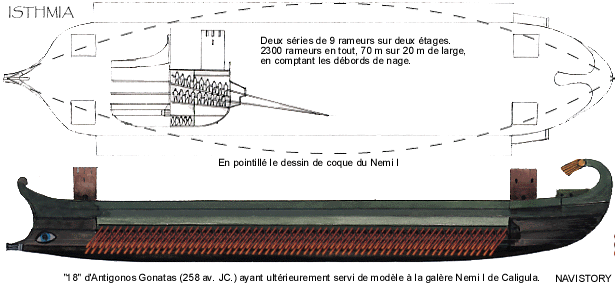
The Isthmia, in the colors of Macedonia, of which he was the ambassador, was very different. More sturdy (20 meters wide but only 70 meters long), it was slightly slower but still had 2300 rowers in two rows (rows of 64 oars), but much more manageable and stable, more powerful and devastating in Ramming.
These two illustrations describe two of the Leviathans of that period. Incarnating two different philosophies, they were none the less remarkable in their perfect incarnation of a genre that was not to survive the classical era. It was the reign of ships that no engraving, or even any remnant, proved beyond presuppositions from concordant accounts of many ancient authors. We were obliged to admit the existence of vessels at 4, 5 and up to 40 levels of superposed oars, which seemed absurd, If not to resort to the ancient method, as practiced by the pirates and peoples of the sea, betting with their Hemioliae (and Liburnes) on a great maneuverability precisely by multiplying the number of rowers per bench. From there, and without arriving at ships of delirious proportions, it became possible to open the veil weighing on this ancient enigma of marine archeology. A “16”, for example, could very well be a simple trirel lining up 7, 6 and 5 rowers per bench.
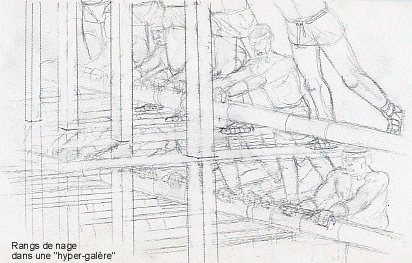 Given the difficulty of managing three levels of oars handled by a single man (tested during Coates and Morrisson trials), what about ships lining up to Famous “40” of Ptolemy Philopator – 10 rowers per bench? The only consideration of the point of leverage is a puzzle for a good mathematician. Two certainties, however: Such a rowing had to be so long that it must also be massive (which is attested by the rare wooden oars preserved dating from the seventeenth century) and necessarily have handles because it can not be caught directly at full hand.
Given the difficulty of managing three levels of oars handled by a single man (tested during Coates and Morrisson trials), what about ships lining up to Famous “40” of Ptolemy Philopator – 10 rowers per bench? The only consideration of the point of leverage is a puzzle for a good mathematician. Two certainties, however: Such a rowing had to be so long that it must also be massive (which is attested by the rare wooden oars preserved dating from the seventeenth century) and necessarily have handles because it can not be caught directly at full hand.
Moreover, the declivity of rowing presupposed an equal declivity of the upper bench, pushing up the deck of the ship, making it highly unstable for lack of ballast in the lively works, and above all, a very large gauge of the first rower facing The aposti and thus a much larger swimming span, almost doubling the width of the ship in relation to its waterline, adding further difficulties in stabilizing it in rolling… Nothing preventing Of the rowers are standing, the last ones at the end of the train making a real walk with return in addition to their traction / push forces, bearing all their weight on the oars. This led to internal bridges or full bridges, which was difficult with offset rows of low height. Whatever the case, construction, maneuvering and learning to swim should be particularly difficult.
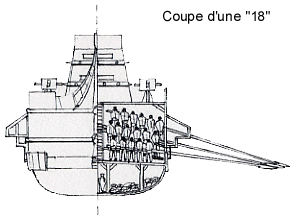
A “twenty” Lagid. This fleet lined up a single specimen, provided with three rows of oars. It was disappointing in front of the “thirty” then built in two copies.
It is very probable, indeed, that the rowers in the “hyper-galleys” (more than five rowers per rowing) were standing, so that the last rowers, which were furthest away from the rowing point, Make a displacement over three or four steps at least (amplitude of two meters), this distance decreasing until the rower closest to the apostis. It seems inconceivable under these conditions that there were seated rowers and others standing on the same train. Finally, the fact that the rowers were standing and evolving in length raises the problem of bridges: One must imagine for a “40”, four bridges complete superimposed, which seems to carry the ship to colossal heights and suddenly becomes implausible.
On the other hand, maintaining a reasonable height, especially for the “40” which was to have four rows of trains each handled by ten rowers, the thranites provided the greatest effort because of the length of the train compared to the height of the row. And, on the other hand, the rowers were staggered to the height of the half-body, which excludes anything other than a single swimming chamber for all rowers, an immense space punctuated by longitudinal cross-pieces, offset gangways for rowers, The transverse and vertical beams…
The internal structure of this room was to be a real nightmare for any naval architect of the time (caprice of princes …) The fact that these oars were provided with handles seems obvious as its width Was considerable (we speak of four-tonne oars and more than seventeen meters for the tekkerakonteros.) The other difficulty of the ream was its great fineness compared to its length (problems of torsional strength and flexibility to that time ). Were there any young pines chosen on purpose? Or of another species of which one joined several decreasing sections, beveled and surrounded by a ring of metal or ropes?… The mystery would require a reconstruction – at least of a side…
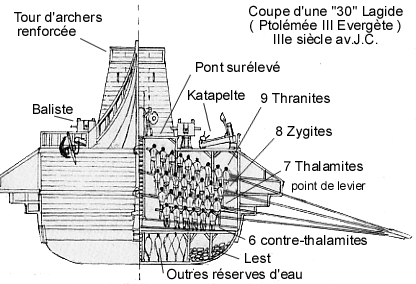
We know that the Lagids had a fleet of considerable proportions (the equivalent of the Royal Navy in 1914 or the US Navy today), not only numerically but also qualitatively with a high proportion of “7”, “6”, “9”, and “11”,”12″,”13″ known as “breaking “…(See Lagide fleet). The Macedonians were not to be outdone, including the exacerbated naval rivalry between Ptolemy II and Antigone Gonatas (see Macedonian fleet), which gave birth to fabulous pachyderms. Some independent cities also built them. Syracuse, certainly, since it sold to Ptolemy its Alexandrian merchant ship of biblical proportions, but merely derived from the Corbites built to convey the corn from Sicily to Italy. Rhodes, acclaimed by both her experience and her visionary spirit, held on to reasonable ships, but she undoubtedly possessed at least one “dekere”. Pergamos, who fought both Macedonians and Seleucids at the pleasure of alliances, also possessed a considerable fleet, and at least ten “cataphract ships”. Each sovereign of the time proved the power of his nation on the seas by sporting these wooden giants.
Nemo ship model
Model of the remains of the “Nemi I”. Vessel much more marine than the Floating Palace Nemi II. Very broad, it had three pins, and its height, deduced from the prow and the drift, was rather small. The Nemi I measured 70 m by 20 m and was propelled by the oar, but in a disposition that remains mysterious. (Http://nemiship.multiservers.com/archeo/)
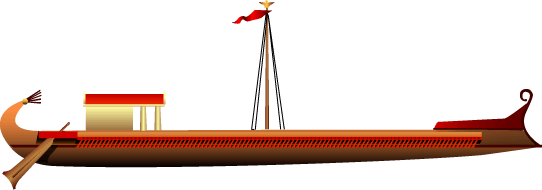
Summary reconstruction, according to the work of the Italian archaeologists in 1930.
Finally, this maritime epicentenary found its epilogue during the battle of Actium, consecrating the end of the last great Hellene fleet at the same time as the time of these “hyper-galleys”, outclassed by a new technique, judiciously compared After the confrontation of the battleships with the torpedo boats at the end of the 19th century. But the final word certainly comes back to late Roman nostalgia, especially those of Caligula, the emperor who built two giant ships dedicated to Diane to sail on Lake Nemi. Both were discovered in 1930 by partially emptying the lake, confirming the writings of Suetonius. The first, called Nemi I, was the supposedly exact replica, for according to the descriptions made by Pausanias, he admired it at the Sanctuary of the Bulls at Delos of the Isthmia, which had been there for centuries. The Nemi II was a rematch a simple floating palace almost as wide as long, and in no way marine, just good at becoming the focus of naumachias on a large scale. The two ships, recovered in good condition (bactericidal vases), restored and kept in sheds, were unfortunately burnt by German soldiers-by the SS, pure vengeance of the Italian armistice-during their retreat at the beginning of 1944. This loss is Also a technique of construction that could have told us much more about these famous galleys, a void that does not fill the “modest” ship of Marsala.

GREEK MERCHANT SHIPS
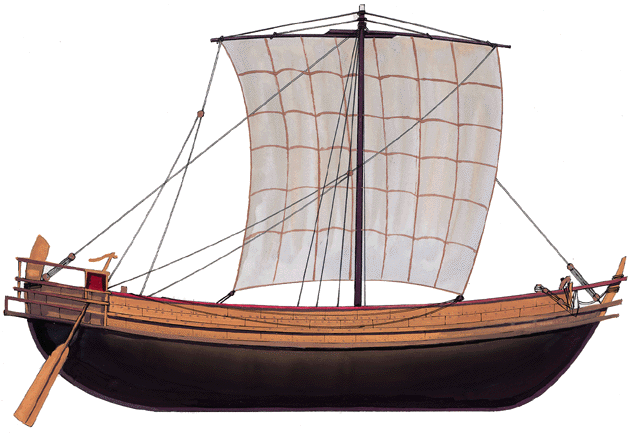
A light cargo model such as there were hundreds in Phocaea, an Athenian colony (Massalia, then Marseille)
The coasters that joined the coasts of Macedonia and Asia Minor in the glory days of Hellenism and made the link between the eastern and western Mediterranean were very simple, with a single square and double sail made harder by reefs Cross-sections. A ship of this type, with a crew of some sailors, could carry up to 150 amphorae in its single hold. Length of 20 meters at most and wide of 5, this voluminous ship was naturally built by clinkers and its lively works coated with bitumen and pitch. Divers regularly continue to discover it, so this type of ship is relatively well known to us.
KATAPHRAKTOI trade ship
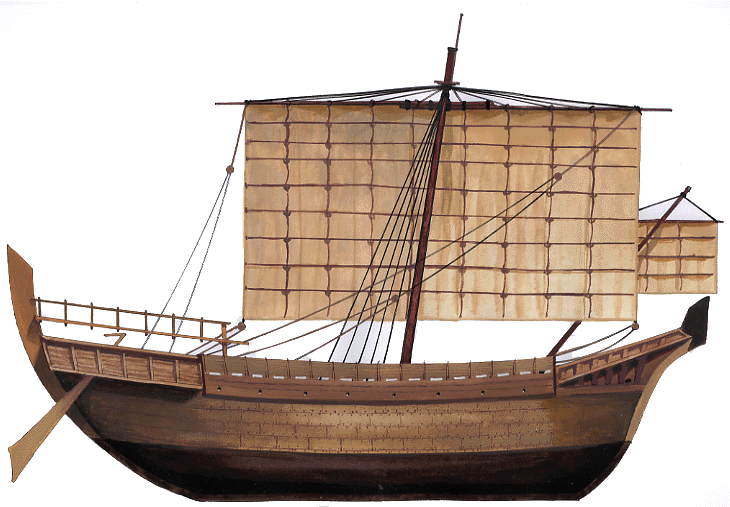
Type of heavy freighter of the Hellenistic period. The Romans with their Corbita will be much greater.
These “Kataphraktoï” cargo ships of 300 tons or more (knowing that a “standard” Greek amphora was 19.4 liters) could reach a deadweight port of 5000 to 10 000 amphorae. The latter were equally suitable for the transport of large quantities (wheat from Minor Asia, Egypt and Sicily, barley from the North), but also wine, olive oil and honey, Exported throughout the Mediterranean basin. These vessels, which were relatively fast, often had ladders used to cut off access to the wharf. An additional sail at the bow used them for harbor maneuvers, as the oars were gradually abandoned with the progress in the use of sailing. However, the first Greek cargo vessels used rowing largely, and their relatively low width / length ratio made them suitable for military as well as civil use.
SELEUCID SHIPS

Battle of Eurymedon, 190 av.J.C.

The same Penter under sails.
Unknown, the modest fleet of this immense empire, heir to the greater part of that of Alexander, was a reality only from its proclamation by one of its generals, Seleucus, son of Antiochos, in 312 BC It was the largest of the three great empires, extending from the shores of Asia Minor to the Indus. Such a continental immensity would constitute, not an advantage, but a heavy handicap. To maintain the cohesion of this empire of Hellenistic culture but peopled by so diverse nations, on vast territories, often poor, mountainous, arid, difficult provinces of access, cultures and religions antagonists and Satrapes not respectful of power Royal progressively provoked the dismemberment of the empire, and from 301 to the battle of Ipsos, the Kingdom obtains the maximum of its extension. In 281, however, wars against the Lagides were to provoke the conquest of the greater part of Asia Minor, Lycia and Cilicia alone remaining in the hands of the Lagides. Despite the founding of two capitals, Seleucia of the Tigris and Antioch of Syria, the empire was slowly beginning to disintegrate.
Progressively, kingdoms became independent: Pergamon, Bithynia, Bridge, Cappadocia, but also Media, and intermittently Armenia. The is razzed by the Parni also becomes it under the name of Parthie. Finally, the Greek kingdom of Bactria, the most eastern of the provinces of the empire, was proclaimed by Diodotus, a local Satrap in 240 BC. JC. And restricts the latter to its western part. In 190 BC, the situation was critical. Rome emerged victorious from the first war Punic watches with attention the exhaustion of the Lagids and Seleucids in the interminable war for Coil-Syria, anxious not to let one or the other take the dominion over the Eastern Mediterranean. Antiochos III the Great, who once again tried to reconstitute the empire, had the misfortune to lodge and even to help the famous general Carthaginian Hannibal, exiled after the defeat of Zama, and confided to the latter his fleet, finally beaten At Eurymedon, a prelude to the Roman landing in Asia Minor and the great battle of Magnesia of Sipyle, announcing the withdrawal of the empire and the end of the Mediterranean fleet. The peace of Apamea was a prelude to its disintegration of what remained of the Seleucid empire: Armenia was definitively lost, then in 164 BC. Persia, the neuralgic center of the ancient empire, and finally Babylonia and Media, by the Parthians in 129 BC. JC., And finally Mesopotamia in 88 BC. Pompey, by causing the murder of Antiochus XII, put an end to his existence in 64 BC.
The Pentere described in this illustration is light, extrapolated from the trire, it possesses three rows of oars, and proved very cramped. It had an almost complete bridge, except for the large openings intended to ventilate the swimming compartment below. Length of 42 meters for 6 meters wide, it embarked 260 rowers distributed in three rows of 26 oars of each edge, the Thranites and Zygites being two and the Thalamites alone for an oar. Also on board were the Navarch, 15 crewmen and about 30 soldiers, epibats and peltasts. With their high height, their more powerful jet weapons and their more numerous soldiers, approaching to the raven, the Romans had a definite advantage.
PTOLEMAIC SHIPS
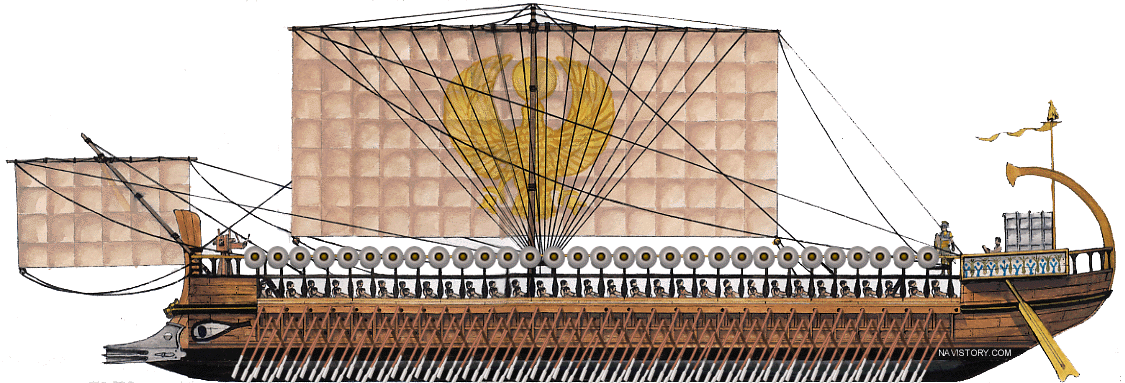
A Penter, to which had perhaps belonged the Roster of Ahlit
The illustration calls for some comments: It is a “light” Pentère with Roman standards, Rhodian construction, but bearing decorative elements drawn from the Egyptian stylistic heritage. The lotus flower in figure of stern and the figure of prow remembers that of the ancient Keftions. The decoration remains sober, although more refined than that of the Macedonian ships. The bridges are widely open, Greek fashion, for the comfort of rowers. This to a corollary, the lack of space for the epibates, slingers, and weapons of jet embarked. The Rostre visible at the front is the “putting in condition” of the Ahlit rostrum, discovered near the city of the same name on the Israeli coast in 1980 is a major discovery for maritime archeology: Conserved in very good condition, This massive cast bronze piece weighs 465 Kilos for 2.26 meters. It was full of teachings on how to design hulls at a time when ramming was still a queen technique. The Pentere was not the preferred unit of the Lagides, who preferred the Trières and Tetres, or, conversely, the much heavier units.

Lagid Eight, Fleet of Cleopatra VII, Battle of Actium, 31 BC.
The Octeres (or Hocters?) Were more frequently used than the Heptera by the Lagids. With slightly larger dimensions, and especially a complete closed bridge, the octere could carry a considerable jet armament and a large number of infantrymen. The Quinquérème Romaine had 120, and the Hepteres and Octeres probably more than 160. The massiveness of this ship is obvious: With 52 meters long for 7.60 m wide (and only 5.50 m at the waterline) It was a very narrow vessel (always for speed), but with a draft of only 1.40 m, rather unstable in roll, which tons of stones embarked partly palliate. The archers’ towers were not a properly Roman characteristic. Although formidable in classical Rostrum against Rostrum (Diekplous) ramming techniques, these elephants of the seas were totally ineffective in front of the manageable Roman Liburnes at Actium which encircled them and prevented their evolutions. Nevertheless, the shock effect of such a mass, associated with a rostrum whose form had been dictated by centuries of empiricism, was to be formidable.

One of the two “30” of Ptolemy III Euergetes (246-221).
This typical “Hyper-galley” was symptomatic of the arms race initiated between Ptolemy II and Antigonos Gonatas, culminating with these two giant units, the largest operational galleons ever built. Unlike the “20” built earlier and yet more reasonable, they were considered effective. Only Egypt and its inexhaustible resources could finance the construction of such giants, built in Alexandria or Cyprus. An enigma for historians who believed (a short time) of having to deal with a galley at 30 levels of oars, it was more likely propelled by 3 rows of rowers with 10 rowers per bench at the most (by analogy with the Tettakontère) , But the decreasing length of the oars calls for a distribution of 11/10/8 rowers, or more probably 4 rows of trains served by 9 Thranites, 8 Zygites (or “Zeugites”), 7 Thalamites and 6 “sub-Thalamites”. The Tettakontère built by Ptolemy Philoptor was inspired by it, but probably had a double hull, which is not excluded for these two “30s”, probably excessively unstable. When the conditions of the rowers, installed on very inclined banks, and probably having to carry out much smaller movements at the point of lever of the ream (the aposti) and much more ample at its extremity, we are reduced to conjectures (see Cutting patterns on the Hellenistic Hyper-galleys page) …
This type of giant ship probably had to have a fixed rig, just the sails were carved before the fight, and assistances in the rear drift, too heavy to maneuver with bare hands, but through a mechanism Demultiplier. The “Thirty” Lagide could very well have been a parade ship because of its exceptional dimensions, but the fact that it was duplicated argues in favor of a military operational unit. This galley thus possessed about 1860 rowers in the configuration retained here, with about 400 troops, including archers, peltastes and epibates, as well as serving as throwing weapons, here 8 “petroleum” capable of throwing fire pots And stones, as well as 4 ballista. Hard of its internal configuration, having rowers standing, the central part was covered with a footbridge and raised above the swimming chamber. This gives us a length of about 100 meters for 20 meters wide, and almost 28 counting the debarks of the swimming chamber. It is possible that a ship of this type was present at the Battle of Actium in 31 BC, still judging from the enormous rostrum dwellings of the Aktia Memorial Shrine (the present name of the cape) , The largest measured, was to house a room nearly 2 meters wide, 2.50 m high for 4.50 long and a weight of about two tons in solid bronze…
During most of the post-Alexandrine history, at least until the first Punic War between Rome and Carthage, two naval superpowers dominated the Mediterranean: to the west the Carthaginians and their formidable fleet of war, East, dominating the whole eastern part of the Mediterranean, the fleet of the Lagide Empire. This empire was ruled by the Ptolemaic dynasty, the last of Egypt as a great independent power. Ptolemaios was one of the generals of Alexander, son of Lagos (nickname of a brilliant Macedonian warlord, general of Philip II), and who came to Egypt on the partition of the empire of Alexander the Great after his Died in 331 BC. He was first Satrape of Egypt, then Pharaoh (Ptolemy I Soter “savior”) in 305 BC. Until 30 BC (date of assassination by Octave of Caesarion, presumed son of Cleopatra VII and Caius Julius Caesar), who was “co-pharaoh” (Ptolemy XIV) from 36 to 30 BC . Between these two dates, the Lagide dynasty, symbolically faithful to Egyptian customs, culture and language, brought in the naval science of the Hellenes, and the Egyptian ships of that time had nothing to do with the “soft boats” Used a millennium earlier.
The Lagide Sovereigns regularly found themselves in conflict with the other descendants of the Diadochians, the Seleucid dynasty and the Antigonids of Macedonia. As a result, they needed more and more powerful ships for their military operations by virtue of an arms race that recalled the worst materialistic drifts of the 20th century. The Lagide fleet was almost entirely composed of heavy units, notably the standard of the time, the Pentère. It also aligned Hexeres, Heptères, Hoctères, and Dékères (at 6, 7, 8, 10 oars per lane) in quantity. With the advent of Ptolemy II Philadelphus (283-246), the Lagide fleet reached its rank as the largest ancient naval power (by far), aligning a permanent fleet of 336 vessels, of which 224 Trières and Tetres, Frames, and “monsters” intended to pierce the enemy front, with no less than 17 Pentères, 5 Hexères, 37 Hepteres, 30 Nonères, fourteen “11”, two “12”, four “13” A unique “20” belonging to his father. These latter units were much more demonstrative than maneuvering.
This gigantic race will be won by Ptolemy IV Philopator and his Tettakontère (Tesseracontère) with four rows of ten rowers for each bench. These galleys were very similar to those used by the other Hellenes, and especially built in Cyprus, or by Tyr and Rhodes, which supplied themselves with wood from Lebanon. (The rich forests of Coile Syria will be a recurring battlefield for Lagides and the Seleucids). But the main confrontations were not made against Carthage, since the Phoenicians, the great suppliers of the Lagos, and the “blood brothers” of the Carthaginians would not have accepted it, but mainly against Macedonia, with the major confrontation between Antigone Gonatas and Ptolemy II. (See also Macedonian fleet). The last major naval battle of the Lagide fleet is a milestone for the story: This victory of Actium, as well as consequences for the naval tactics of the time (the end of the massive galleys in favor of light units ), And on the geopolitical level the end of the Lagide fleet (the Mediterranean after the fall of Carthage became a “Roman lake”), and also that of Egypt itself, since it became a Roman colony of The Augustian empire being born.
The legendary TESSERACONTER

The fleet of the Ptolemies, of its Greek, or rather Macedonian origin, had the techniques of construction and the taste for large ships, adding to it the pomp of the Pharaohs. A genuine monster, this galley-palace, and at the same time the flagship of Ptolemy Philopator’s fleet, was a “40”, counting forty men on board, with 4000 rowers according to the writings, indicating that each row 17 meters long Could be handled by ten men, and that, consequently, this galley might have four rows of oars, or three with sixteen, thirteen, and ten rowers, the oars of the highest ranks being distinctly longer, which appears to be less likely. Be that as it may, these oars were so large that they could not be seized directly, but by means of “handles” made for this purpose. The rowers had to be very shifted and have a role to play different according to its distance from the apostis, the lever point of the rowing.
A mysterious vessel whose existence is reported, it is difficult to know its dimensions, varying from 120 to 80 meters, and between 15 and 30 in width, and 50 with possibly a double hull. Because of its imposing draft, this ship could not dock in any port, remaining in the open sea. Or a contrario it is very possible also that it was launched, but remained docked like the floating palaces Of Caligula a few centuries later on Lake Nemi, its enormity condemning it on the contrary not to cross the boundaries of its dedicated basin. Preceded by the “20” of his father Ptolemy Philadelphus, and perhaps inspired by the “30s” of the fleet, this naval unit superfluous of the last Ptolemy constituted the high point of the rivalry between the Antigonides of Macedonia and Egypt Lagide.
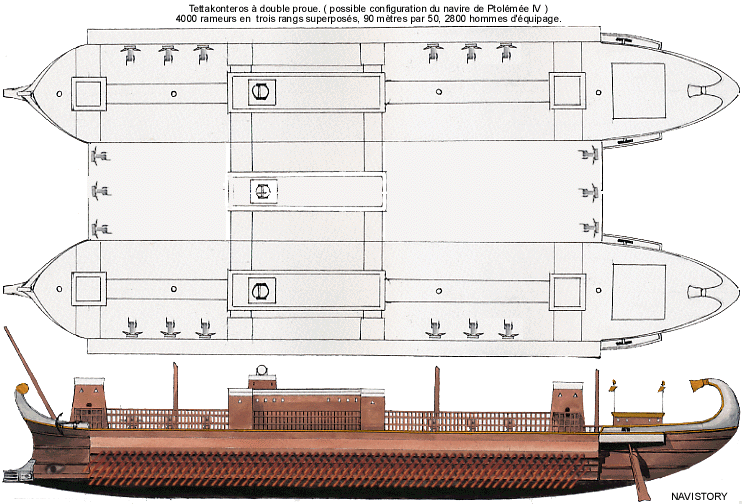
This mythical ship probably poses the most beautiful enigma to archaeologists, but also to engineers. It is common sense to challenge such gigantic galleys, as the trials of Coates and Morrison in the 1980s proved that this system works but is already complex with only a rowing rower . First of all, 4000 rowers, for a squad of 40, this inevitably means that there were necessarily at least four rows of stacked oars, with ten rowers for each. It is difficult to imagine oars of more than ten men. Then, the superposition of the rows poses the problem of the length of the oars: The “counterthalamites” (lowest rank) should have provided a much less effort than the Thranites because of the increasing length of the oars going towards the top. And ten rowers are still a lot: This poses the problem of the position of the internal rowers with respect to the point of lever of the train: Too close, their effort would have been derisory or on the contrary too important for a mediocre result. Removing the rowers also means that the famous lever point of two or three meters and more (notably by advances in the swimming chamber) must be set aside, and inevitably poses that of the length of the oars, which for ten rowers , Brings us to much more than 17 meters regarding the thranites…

It is doubtful that 8 rowers is already a maximum possible, and is more compatible with the length of the oars (17 meters) as described by Casson, who mentions the special nature of this galley, which would have had a catamaran configuration: Of “20” joined by a large platform, which would have given 1000 rowers distributed in 50 rows of oars in 8 thranites, 7 zygites and 5 thalamites, 2000 rowers thus for each hull, which thus seems much more credible. Such a ship would have had a lower draft and therefore greater mobility, very good stability as well as ample space available for jet weapons. In addition the “40” was deemed to carry 2850 soldiers. (See illustrations). In such a configuration, the two “30s” of Ptolemy III could also have been two catamarans, meeting two “15”. The Lagide fleet had a great experience of units above dekere (10), and had no less than fourteen “11”, two “12” and four “13”. See also John Illsley’s article (In English) (Southampton University, Maritime Archeology Section, http://cma.soton.ac.uk/HistShip/shlect27.htm).
Lighter ships: The Hemiolia
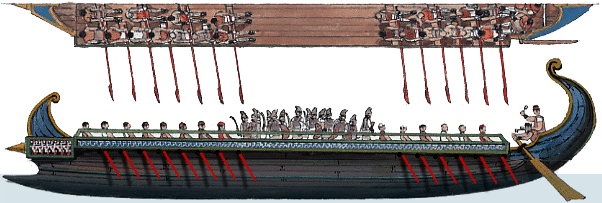
Thracian Hemiolia, rampaging the Aegean or Black sea from a description on a Roman bas-relief. The central part is cleared, the space lost being compensated by double row.
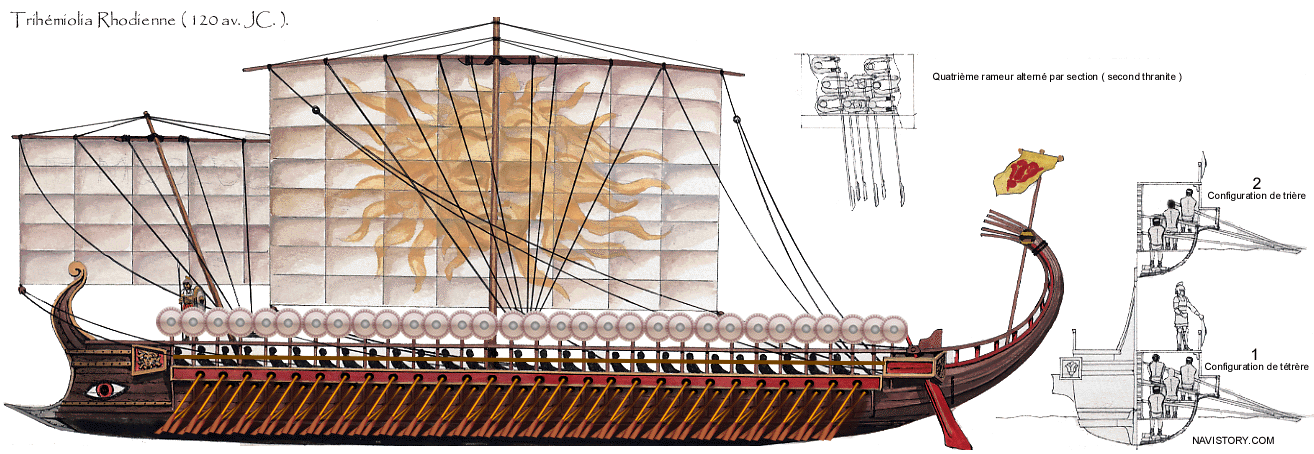
Rhodian Trihemiolia, 120 BC. This was a “cataphract” (full deck), intermediate between a trireme and a tetrere.
The Hemiolia was a light ship, generally classified in the “aphractoï” (unbounded), peculiar to the pirates of the Aegean Sea (Chios, Lesbos, Lemnos, Sporades and Cyclades) and Asia Minor, Like the Cilicians, contrary to liburnes and lemboi, proper to the Adriatic. The configuration of these vessels remains controversial. They were sailing ships, light, small, but slightly wider than the classic monuments, having one man and more by rowing, unlike the triacontores and pentacontores. The interpretations diverge as to their configuration of rowers: According to John Morrison for example, the Hemiolia would be a monomer in which the oars are handled by two men only in the front and the back, the central part or before having A rower, in order to clear the bridge for the maneuvers of the sail as a place for the combatants.
The Thrace hemiolia above would be even more absolutist, since having two rowers per oars, but none for the central part, totally unobstructed. The dihémiolia would comprise the same system, but in the manner of the dieres in two rows, and the trihemolia, logically that of the triremes, with the difference less oars per flank (not more than 25 like the pentecontore). However, Morrison speaks for the trihemolia of two rows, arguing that dihemia is not mentioned anywhere, unlike Casson who thinks of three rows in this case, but two for the hemiolia, which for him reserves the possibility of To dismantle the central part of its rowers (with a rowing rower) in order to be able to put away the sail and dismantle the mast, which Morrison disputes by arguing that to disembarrass the rowers at the moment when the sail is deposited is precisely illogical.
For Suzanne Ellis, (student) the Hemiolia would have two men by rowing, on one row, but only for half the length (“hemi” means “half”). The trihemiolia would have two rows (it does not speak of dihemiolia). It would be mentioned as the principal ship of Rhodes, probably to better combat piracy and its light vessels, the trihemolia being partially bridged like the Greek triremes. The Greeks (mention for the Athenian fleet) and the Lagids would have disposed of them within their forces.
These ships were considered to be more manageable than triremes. The trihemolia would then not be a galley in which the central part is stripped, but a kind of trireum in which two men handle the upper rowing. (See section), which seems to come very close to a simple variant of the trire. For Michael Williams, another student in maritime archeology, this distribution would go by section, the hemiolia having a single rank but maneuvered by one or two men alternately by section. The trihemiolia would have the same system applied on two rows, see three, and alternately 3/4 men per side, which would make it a ship-in the case of thirty oars per row intermediate between the tether and the trire, and More cataphracte (bridged), far removed from the pirate ships of the Aegean Sea…
My personal opinion is that, in the absence of a real description (bas-relief, mosaic), but according to written indications, these ships must be logically considered taking into account the Greek term “half”. Indeed, the solution by alternation of section seems plausible. The hemiolia in this case could be in a configuration of 1/2 alternating rowers per section, dihemia 2/3 (on two rows) and trihemiolia 3/4 on three rows, considering that only pirate hemioliae would have been inspiring , The purely military derivatives (such as the heavy Rhodian trihemiolies, moreover, inventors of the tether, upper echelon), being first-line cataphraw vessels.
I do not see much interest in clearing the central part of the bridge, but on the other hand – as Morrison talks about, the clearance of the front seems more logical. The two solutions (full alternating edge and partial front edge) intersecting the same direction, but with the same difficulty of oars of the same length (obligatory rank), obliging to choose in the chiourme the men strong enough to handle one Rowing done for two. (Were there alternations along the way?). The same problem was repeated for the higher ranks…
Small ships, “naval dust”
Lemboi

Lemboï, later romanized as “Lembus”, was the fetish ship of the Illyrian pirates (Illyria is the present Croatia, with part of Slovenia), which controlled all the eastern part of the Adriatic, The law, at least until the Romans took matters into their own hands at the urging of the razed and ransomed cities, and made Illyria of Teuta (the mythical “queen of pirates”) one of their First colonies. The Lemboi were also cited by all Greek authors since the fifth century as small boats that only row, sometimes with more than 18 rowers. They were bridged only at the extremities, very rapid, 12 to 18 meters long and 3 to 4 wide. Polybius mentions that Philip of Macedonia used about 180 BC. JC. Of the Lemboi to transport his army. The pirates were at the same time rowers and fighters, the distances to be traveled were too short to have the utility of a large hold or a sail. The lightness of the Lemboi allowed them to be hauled on the beach at night.
Keles
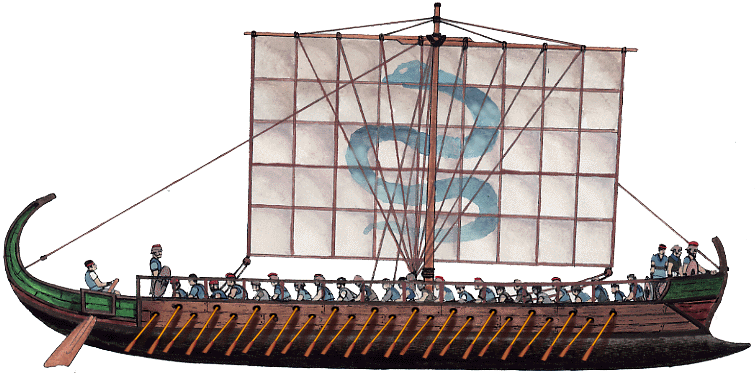
A Keles Katascopos of Illyrian pirates (220 BC). The shields are not shown here on the bulwarks to observe the arrangement of the rowers.
The Celes (in Roman) was in fact a ship inspired by the Greek Keles, ships of low tonnage not decked, peculiar to the peoples practicing the piracy. It was encountered both in the Adriatic and the Aegean. This term is at the origin of the adjective “celerity”, and to put in relation with the horse (the horse of saddle assimilated to thoroughbred in the Romans). It can be compared to the Lemboi (Lembus) and it seems that it was larger and veiled. One thing is certain, it is his configuration of rowers, with a rowing rower. The “dière” configuration is here a simple way to save space, in order to preserve the maneuverability. The model shown here is a reconstruction of Kelês Katascopos (quick scout). It can be compared to a two-row pentecontent, as it has two rows of twelve rowers (48 in all, which are also fighters), but Much more stocky and manageable. This gave around the 1st century BC the Celes Catascopius, scout of the Roman fleet, preferred to the pentecontore, too long, to the liburnus, too heavy, or to the emblem, too light.
Kibaya/Cybaea
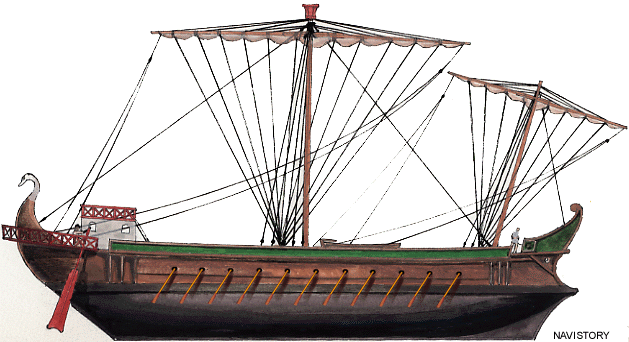
Roman Cybaea (50 BC), here with a prow with a protective spur.
The Cybaea or Kybaia in Greek was a bridged commercial vessel, relatively heavy, maneuvered to rowing for approaches or lack of wind, and equipped with two masts. There is no known representation but a few mentions taken from various ancient texts Romans and Greeks. According to Lionel Casson, this ship was also related to the Kerkouros (See Curcurus), but much larger and very crushed prow-like barges. The name related to “cubic” or angle would incline for a ship of mixed vocation, fluvial, like pontoon, and maritime at the same time, and walking with the oar and the sail.

Help support naval encyclopedia !
Src/read More
http://www.hellenicaworld.com/Greece/Technology/en/GiantShips.html
https://weaponsandwarfare.com/2020/07/10/the-rise-of-the-super-galley/
http://www.cogandgalley.com/2009/02/evolution-of-roman-imperial-fleets.html
https://en.wikipedia.org/wiki/Hellenistic-era_warships
Athenaeus, The Deipnosophists, Book 5, (Loeb Classical Library No. 208, Harvard University Press, 1987)
The age of supergalleys (PDF File) Selection from Casson, L. Ships and Seafaring in Ancient Times 1994
Casson, “The Super Galleys of the Hellenistic Age,” Mariner’s Mirror 55 (1969) 185-93 (PDF)
Casson : The Age of the Supergalleys (PDF)
Lionel Casson, The Ancient Mariners: Seafarers and Sea fighters of the Mediterranean in Ancient Times (2nd ed.), Princeton University Press, 1991
Lionel Casson, Ships and Seamanship in the Ancient World , Princeton, N.J., Princeton University Press, 1971. ISBN: 0691035369
Deborah N. Carlson, Caligula’s Floating Palaces Volume 55 Number 3, May/June 2002
LINKS
-La plus grande galere de l’antiquité: Dimensions et forme de la coque
Another Comparison including the Leontophoros of Lysimachos and the 187 meter long HMS Belfast ( Europe’s last big gun armoured warship of World War II The HMS Belfast )
The Ptolemaic Dynasty
Die Kriegsschiffahrt zur Zeit der Griechen
Basch L. , The tessarakontores of Ptolemy IV Philopator. Mariner’s Mirror, 55: 381-382, 1969
HISTORY AND ARCHAEOLOGY OF THE SHIP – General Bibliographies.
Imperial Roman Warships 193–565 AD (New Vanguard): D’Amato, Raffaele, Rava, Gius

 Latest Facebook Entry -
Latest Facebook Entry -  X(Tweeter) Naval Encyclopedia's deck archive
X(Tweeter) Naval Encyclopedia's deck archive Instagram (@navalencyc)
Instagram (@navalencyc)





 Austrian Navy
Austrian Navy French Navy
French Navy Royal Navy
Royal Navy Armada Espanola
Armada Espanola K.u.K. Kriegsmarine
K.u.K. Kriegsmarine Dansk Marine
Dansk Marine Nautiko Hellenon
Nautiko Hellenon Koninklije Marine 1870
Koninklije Marine 1870 Marinha do Brasil
Marinha do Brasil Osmanlı Donanması
Osmanlı Donanması Marina Do Peru
Marina Do Peru Marinha do Portugal
Marinha do Portugal Regia Marina 1870
Regia Marina 1870 Nihhon Kaigun 1870
Nihhon Kaigun 1870 Preußische Marine 1870
Preußische Marine 1870 Russkiy Flot 1870
Russkiy Flot 1870 Svenska marinen
Svenska marinen Søværnet
Søværnet Union Navy
Union Navy Confederate Navy
Confederate Navy Armada de Argentina
Armada de Argentina Imperial Chinese Navy
Imperial Chinese Navy Marinha do Portugal
Marinha do Portugal Mexico
Mexico Kaiserliche Marine
Kaiserliche Marine 1898 US Navy
1898 US Navy Russkiy Flot
Russkiy Flot French Naval Aviation
French Naval Aviation Russian Naval Aviation
Russian Naval Aviation Sovietskiy Flot
Sovietskiy Flot Royal Canadian Navy
Royal Canadian Navy Royal Australian Navy
Royal Australian Navy RNZN Fleet
RNZN Fleet Chinese Navy 1937
Chinese Navy 1937 Kriegsmarine
Kriegsmarine Chilean Navy
Chilean Navy Danish Navy
Danish Navy Finnish Navy
Finnish Navy Hellenic Navy
Hellenic Navy Polish Navy
Polish Navy Romanian Navy
Romanian Navy Turkish Navy
Turkish Navy Royal Yugoslav Navy
Royal Yugoslav Navy Royal Thai Navy
Royal Thai Navy Minor Navies
Minor Navies Albania
Albania Austria
Austria Belgium
Belgium Columbia
Columbia Costa Rica
Costa Rica Cuba
Cuba Czechoslovakia
Czechoslovakia Dominican Republic
Dominican Republic Haiti
Haiti Hungary
Hungary Honduras
Honduras Estonia
Estonia Iceland
Iceland Eire
Eire Equador
Equador Iran
Iran Iraq
Iraq Latvia
Latvia Liberia
Liberia Lithuania
Lithuania Mandchukuo
Mandchukuo Morocco
Morocco Nicaragua
Nicaragua Persia
Persia San Salvador
San Salvador Sarawak
Sarawak Uruguay
Uruguay Venezuela
Venezuela Zanzibar
Zanzibar Warsaw Pact Navies
Warsaw Pact Navies Bulgaria
Bulgaria Hungary
Hungary

 Bundesmarine
Bundesmarine Dutch Navy
Dutch Navy Hellenic Navy
Hellenic Navy Marina Militare
Marina Militare Taiwanese Navy
Taiwanese Navy Chinese Navy
Chinese Navy Indian Navy
Indian Navy Indonesian Navy
Indonesian Navy JMSDF
JMSDF North Korean Navy
North Korean Navy Philippines Navy
Philippines Navy ROKN
ROKN IDF Navy
IDF Navy Royal New Zealand Navy
Royal New Zealand Navy Egyptian Navy
Egyptian Navy South African Navy
South African Navy

































 RN
RN
 Marine Nationale
Marine Nationale
 Soviet Navy
Soviet Navy
 dbodesign
dbodesign